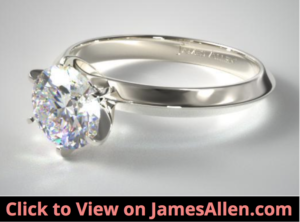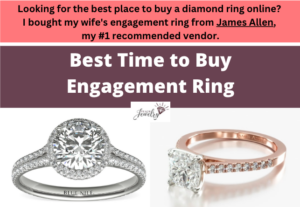
When you’re in the process of buying an engagement ring, your mind isn’t only thinking about color, cut, clarity, and carat. You’re thinking about the life you’ll spend with your partner and how the ring symbolizes that commitment to each other.
But during the search for the right ring, you inevitably come across an unavoidable consideration: price.
My bottom line recommendation is that you shouldn’t wait for a specific time in the year to buy an engagement ring. Instead, buy it far enough in advance of the proposal that you aren’t sweating about the ring as the big day approaches.
When Should You Buy an Engagement Ring?
There are certain times of year when you can save on tangential purchases such as settings and upgrades.
But here’s the key: The actual engagement ring diamond, which is the most expensive part, rarely goes on a discount that makes it worth delaying your purchase.
For example, I bought my wife’s engagement ring from James Allen in January, which was a round-cut diamond in this setting.
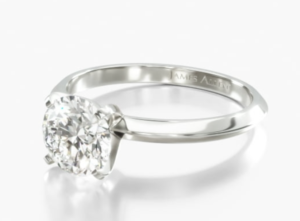
The setting costs $240, so even the 25 percent discount didn’t significantly change the overall cost of the diamond ring.
I still paid full price for the diamond.
On rare occasions, James Allen has offered three percent off natural diamonds, but I don’t think you should wait around for that type of promotion.
That means the best time to buy an engagement ring is when you’re ready. It’s too important of a purchase to hasten or delay based on a potential sale, and as we’ll discuss later, choosing your diamond based on the discount could end up costing you more than you save.
The worst time to buy an engagement ring is when you feel rushed. You’ll be more likely to make a rash decision, neglect to comparison shop, or you’ll later come across a diamond you know would’ve been a better fit. It’s unlikely you’ll find a deal on a quality diamond that makes it worth rushing the purchase.
Buying an Engagement Ring Between Black Friday and Christmas
The rest of the retail world goes on sale between Black Friday and Christmas, so it’s natural to assume engagement rings follow the same trend.
Jewelers often compete for buyers during this time just prior to proposal season by offering incentives such as free settings or percentage discounts of anywhere from 10 to 50 percent off rings.
While these sales are enticing, there are three issues to consider when planning to buy during this time.
First, you’re in serious competition with other buyers, who may have their eye on the same diamond as you.
The second issue is especially true if you order online. You need to have your ring well in advance of your proposal, because you may decide to choose another shape or style once you see it with your own eyes.
Though you should be confident in your purchase before you commit, you should leave several weeks between your purchase and proposal to give you time to make any adjustments or returns.
For example, a friend of mine was recently preparing to propose while a local jeweler was setting his diamond. The initial date he had in mind was coming up, and I cautioned him to not finalize those plans until he had the ring in hand.
It can often take longer than expected to put together the piece and deliver it, and you can’t leave it to chance.
If you’re planning a Christmas or New Year’s proposal, waiting until Black Friday or later to buy a ring carries risk that may not be worth any discount you receive.
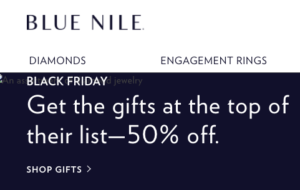
Thirdly, if you see a promotional discount of 50 percent off, it’s almost never referring to actual engagement ring diamonds.
Those discounts are reserved for other types of jewelry, such as earrings, necklaces, or settings.
In almost every case, it really is too good to be true if you see a 50 percent discount and think it means you’ll save $3,000 on a $6,000 ring.
Between Christmas and Valentine’s Day
Buying an engagement ring between Christmas and Valentine’s Day means you’ll likely be competing with buyers who are preparing to propose on one of the most popular days of the year: February 14.
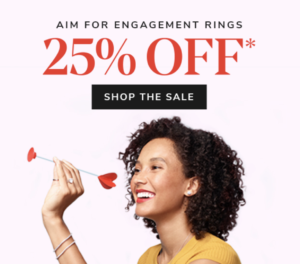
The situation is similar to buying between Black Friday and Christmas.
There’s a chance you’ll receive a percentage discount or a free setting, but the problem of high turnover looms large.
The primary promotions you’ll see will be related to Valentine’s Day.
For example, James Allen often offers a 25 percent discount leading up to Valentine’s Day, but it’s important to note the discount does not apply to loose diamonds or gemstones.
Don’t go in thinking you’ll save $1,000 on a $4,000 diamond. Instead, this type of discount will keep $250 in your pocket if you spend $1,000 on the setting.
While these discounts can still net you several hundred dollars, you have to decide whether timing your purchase to align with these sales is worth it.
During the Spring and Summer
The spring and summer are considered off seasons for buying engagement rings because the primary times to propose are during winter.
That doesn’t mean it’s the worst time to buy an engagement ring.
Like the early fall months, you’ll enjoy less turnover for popular diamonds and be able to find an off-season discount on a setting or other complementary jewelry.
For example, Kay Jewelers has offered 15 percent off on clearance during the summer months.

It may not sound romantic to shop clearance for an engagement ring, but if you’re on a tight budget, it could be worth checking out these options.
Be extra diligent in making sure it’s still a high-quality ring and diamond. As we’ll discover, true quality diamonds rarely go on sale.
Autumn
If you’re considering buying an engagement ring during Autumn, you might feel tempted to wait until the holiday season approaches and begin the process in late November.
But as we’ve discussed, you’ll be disappointed if you wait until the holidays, only to discover the discounts are on its setting, and you have to pay full price for the diamond.
In fact, the most significant discount I’ve seen on diamonds from a quality jeweler is when James Allen occasionally offers 3 percent off natural diamonds and 10 percent off ones grown in a lab.
While the 10 percent can result in savings of hundreds or thousands of dollars, you’d have to buy a large diamond for the three percent discount to change the picture.
So the reason buying an engagement ring during Autumn can be a smart move is because allows plenty of time for a holiday proposal.
Instead of drawing out the purchase only to save $100 or $200 on the setting or natural diamond, you’ll have peace of mind heading into the proposal.
What to Know Before Buying an Engagement Ring
Avoid Buying Diamonds With Steep Discounts
It’s common during the holiday season to see advertisements for jewelry at discounts of 50 percent or more.
While these eye-catching deals might have you thinking about the thousands of dollars you could save and allow you to get a bigger diamond, you should avoid these deals for an engagement ring.
The type of quality diamond most consumers buy for an engagement ring aren’t the kind that go on significant discount.
While a massive discount might suffice for other parts of the ring, avoid being lured in by these deals for the diamond itself.
Buy at Least Two Months Before Proposing
In the weeks leading up to your proposal, you don’t want to be stressed about the engagement ring and whether it’ll arrive on time or won’t have any issues that make you want to return it.
It can take over a month from the time you start searching until you finalize your decision, so it’s best to start looking at least three months out from your proposal and then buy it at least two months out.
The only issue is keeping it hidden from your partner from the time you buy it to your proposal, but that’s less of a problem than not having the ring at all.
Choose Value Over Specific Grades
The best way to save money on an engagement ring is to educate yourself about which characteristics significantly increase its price versus which ones impact its appearance.
My recommendation is to choose a diamond that ranks on the higher end of a lower grade, so the naked eye can’t tell the difference. For example, many buyers want a colorless diamond — an F, E, or D on the Gemological Institute of America (GIA) color scale.
But because these colors are considered a premium, the jump in cost between a G (the highest in “near colorless” grades), is often significant. For a one-carat diamond, it could be the difference of more than $1,000.
But to the naked eye, it’s almost impossible to tell the difference between a G and F colored diamond. So you can save money and get a near-identical look by choosing a G over an F.
The image below is of an engagement ring that meets those criteria.
The same goes for the GIA clarity and cut scale.
For example, I bought a VS1 clarity diamond for my wife’s engagement ring because it was far less expensive than one graded flawless, even when the other qualities were the same. But if you didn’t know it’s VS1, you’d think it was flawless.
Negotiate
It’s often more difficult to negotiate with large chains because they want to maintain consistent pricing standards.
Conclusion
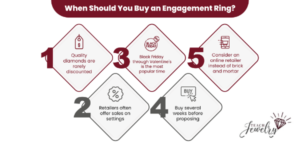
An engagement ring often ranks as one of the most expensive purchases you’ll ever make, so it’s natural to wonder about the best time to buy one.
The answer is although there are instances where you can save several hundred dollars on a setting or negotiate a slightly lower price on a diamond, it’s not the type of purchase you should hold out on for a significant discount.
Instead, the best way to save money on an engagement ring is to educate yourself about diamonds and which factors cause its price to increase or decrease.
Then you can decide which criteria are most important to you and start to comparison shop across the many retailers offering similar engagement ring diamonds.

Jacob Clarke
Jacob Clarke is the founder of TeachJewelry.com.
He earned an Applied Jewelry Professional Diploma from the Gemological Institute of America (GIA) and now brings you essential information about diamonds, settings, and more.
Jacob has consulted with leading jewelry brands, and his work has been cited in Clean Origin, Diamond Nexus and industry publications.
He's also a member of the International Gem Society.
He enjoys discussing jewelry with readers, so contact him with any questions at jacob.clarke@teachjewelry.com.

